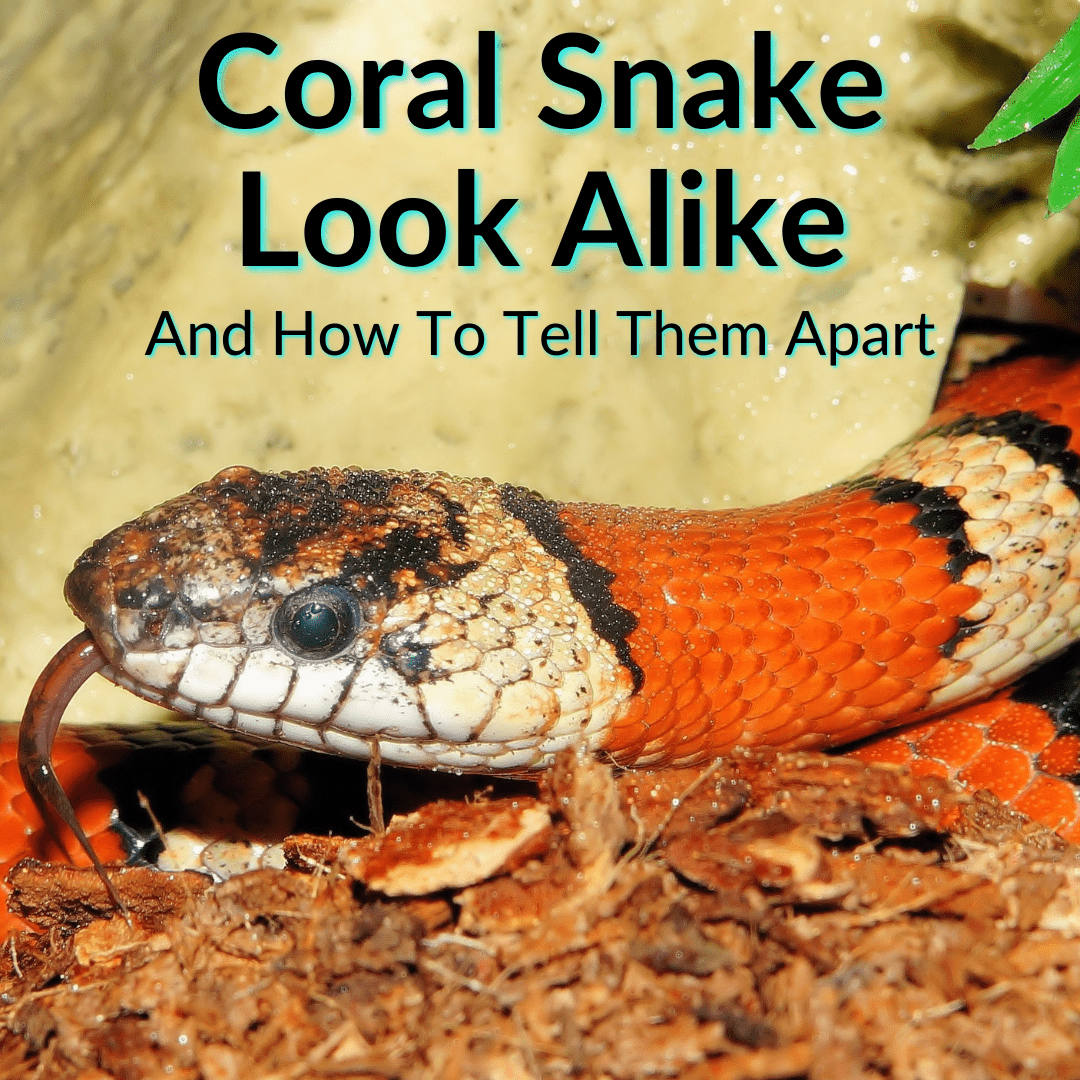
It is beautiful, but highly venomous.
But there are also several other beautiful snakes that look almost identical to the coral snake.
The big difference between them is that these coral snake look-alikes are not venomous.
You can see why it might pay to know how to tell the difference between the coral snake and its look-alikes, right?
Keep reading, because we’ll help you do exactly that. We’re going to look at all of the harmless snakes that mimic the coral snake and tell you how to tell them apart.
Table of Contents
Coral Snake Look-Alike
Coral snakes are venomous snakes with colorful red, yellow, and black bands. Many harmless or nonvenomous snakes mimic the deadly coral snake.
These include milk snakes, scarlet snakes, scarlet kingsnakes, false coral snakes, Sonoran shovel-nosed snakes, and longnose snakes. They have similar colors and markings to the coral snakes and this mimicry protects them from predators.
Let’s take a closer look at the different snake species that look like coral snakes. After that, we’ll look at the coral snake itself and show you how to tell it apart from its non-venomous look-alikes.
Milk Snakes
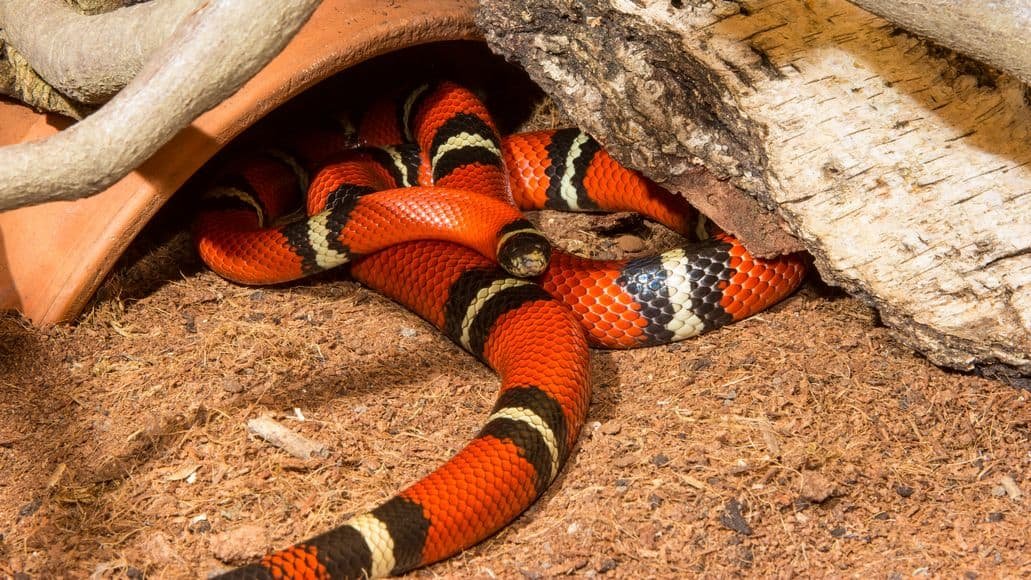
Milk snakes are also tricolored like coral snakes. They typically have white, red, and black cross rings or blotches.
The reddish parts have black borders, and the belly comes with black markings. Milk snakes also have black noses, which is another feature they have in common with coral snakes. Both snake species have stunning patterns that are different, but quite similar at first glance.
This non-venomous snake received its name from the silly notion that it milks cows. This snake is a farmer or rancher’s friend, because the milk snake eats mice and other vermin that destroy grains and food stock.
Milk snakes are found throughout the United States, but their markings tend to differ from region to region. The varieties found in the South and West closely resemble coral snakes.
The varieties found in the North resemble copperheads. This mimicry of venomous snakes helps protect them from their predators.
Scarlet Kingsnakes
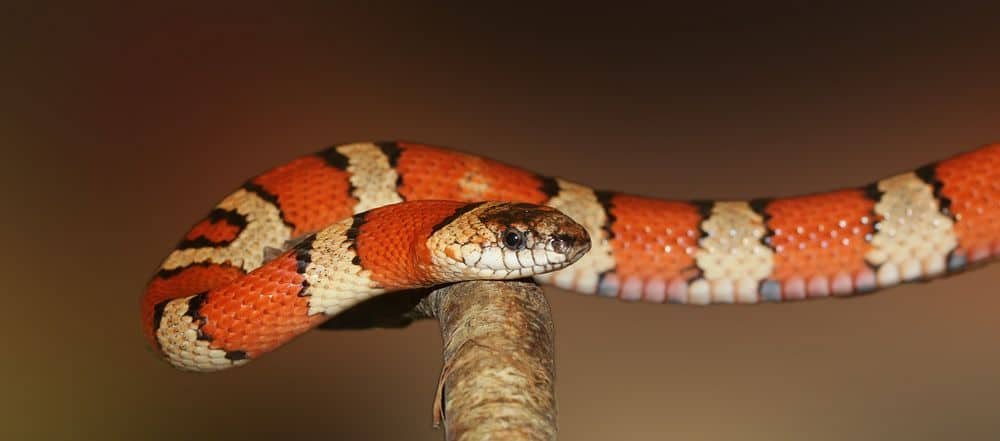
These robust snakes are remarkably like milk snakes and coral snakes. They are ringed completely around the body with red, yellow, and black rings.
The main difference between milk snakes and scarlet kingsnakes is that the milk snake has a black nose whereas the scarlet kingsnake has a red nose.
Scarlet Snakes
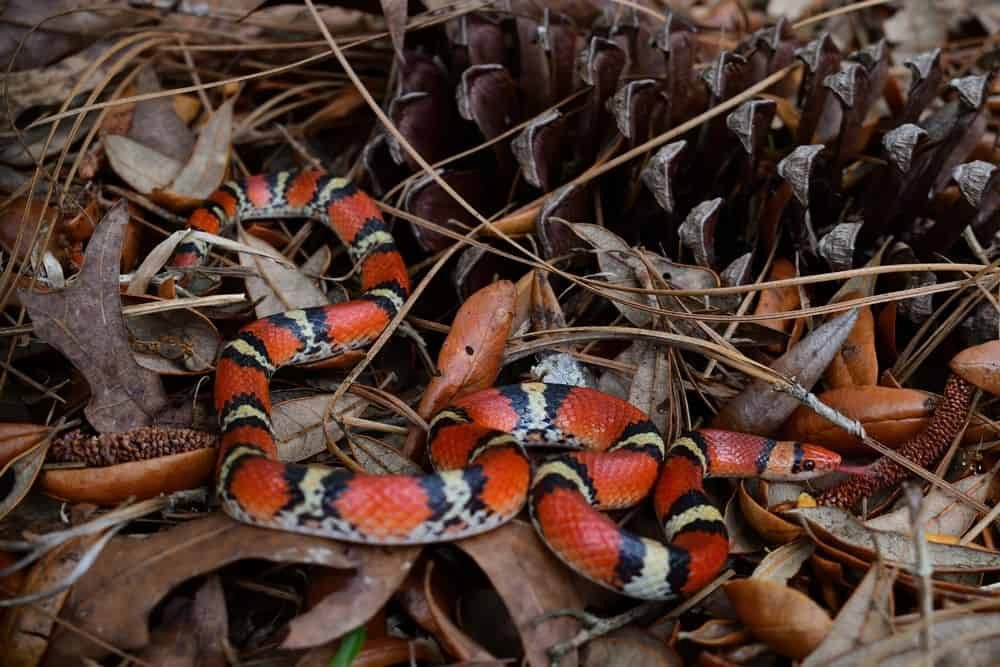
This species is a very convincing mimic of the coral snake. It has white/yellow, red, and black markings. The black and red markings touch each other.
This is the main difference from coral snakes, whose red and yellow markings touch. You can remember the rhyme: “red on black is a friend of Jack!”
When compared to a milk snake, the difference is that the scarlet snake has a plain white belly. Also, it is a burrowing type of snake found mainly in the southeastern quarter of the United States.
The difference between a scarlet snake and a scarlet kingsnake is that in the latter, the bands encircle the entire body.
Florida Scarlet Snakes And Northern Scarlet Snakes
These are sub-species of the scarlet snake. The slight differences between the two include spacing between banding patterns and minor differences in scale numbers.
The underside of the Florida scarlet snake is also white (another major difference from coral snakes). Another thing these scarlet snakes have in common with coral snakes is that they both like to burrow.
Longnose Snake
This nocturnal snake is found in prairies and deserts. Like the coral snake, it has red, black, and sometimes yellow markings. The difference between the two is that the longnose snake is speckled with white.
Longnose snakes also have a unique defense mechanism in that they twist themselves in such a way that blood, feces, and musk get smeared all over themselves and their captor attacker.
False Coral Snakes: Aniliidae
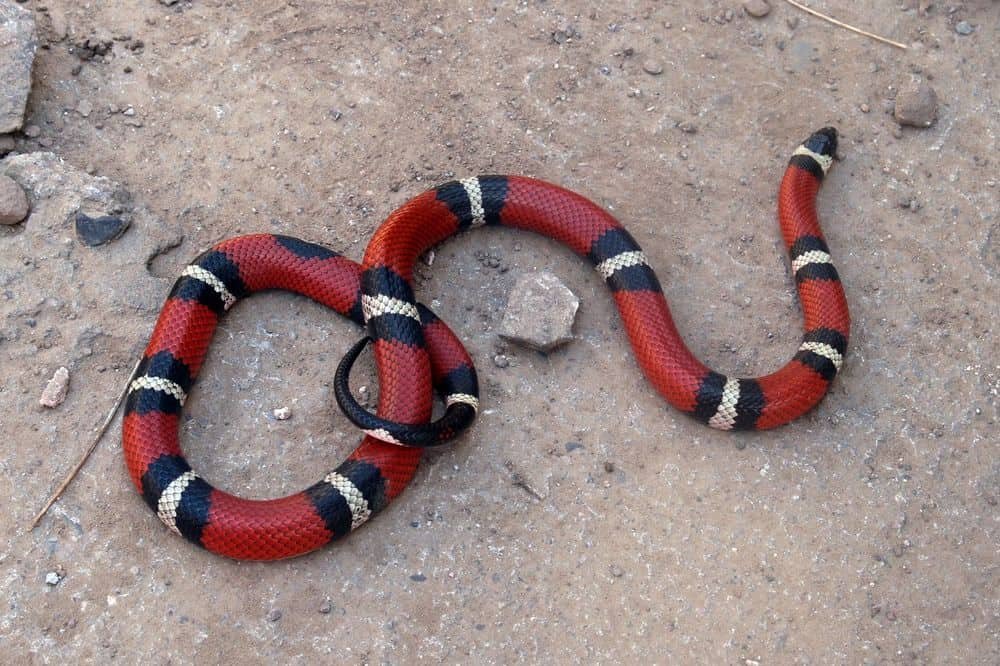
As the name indicates, the False Coral snake is like the coral snake but is non-venomous. It is also called neckband snake or half coral snake.
The colorful false coral snake has a red/orange/pinkish belly. Like coral snakes, it is brightly colored, but has incomplete black bands. The red, pink, and orange bands also have black outlines which give the snake a speckled appearance.
Sonoran Shovel-Nosed Snakes
Many experts consider this the true mimic of the western coral snake, because, in this case, the yellow bands even touch the red! That means we can forget our little rhyme about Jack here.
But the Sonoran shovel-nosed snake is non-venomous. The main difference between it and the coral snake is that the bands do not extend onto the belly.
How To Tell If A Snake Is A Coral Snake
The coral snake is beautiful but deadly. It makes venom inside its body and uses its fangs to pierce its victim’s skin and shoot the venom in. Some species also chew the skin!
Their venom is deadly enough to kill. That is why it is important to be able to tell a coral snake apart from its non-venomous mimics. Luckily, there are key differences between coral snakes, king snakes, milk snakes, and the rest.
Coral Snake Description
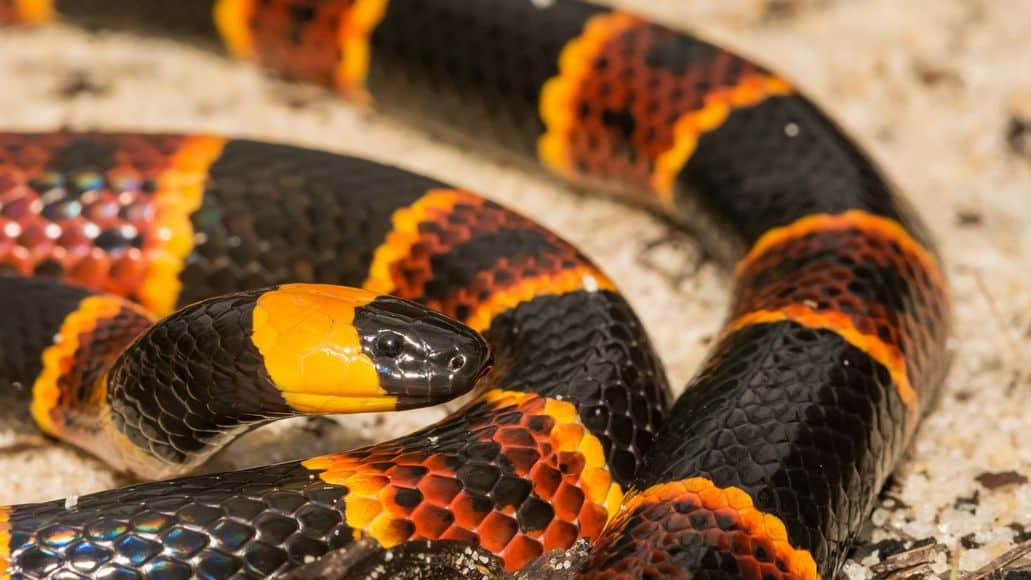
The coral snake belongs to the Elapidae family wherein all members have short, fixed fangs in the upper jaw. There are over 50 species of coral snakes in the USA.
Overall, these snakes are quite small and measure only about 18 to 30 inches (46 to 76 cm). The Eastern coral snake is larger than the Western coral snake.
Coral snakes are slender-bodied snakes with coral coloring. These brightly colored snakes have red bands flanked by yellow bands.
To remember that this snake is dangerous, you can use the rhyme “red touching yellow, kills a fellow”. This differentiates them from the many nonvenomous snakes that resemble coral snakes. These are the main ones.
Here are some points for the identification of coral snakes:
- Coral snakes are small and slender and usually measure no more than 4 feet.
- They have wide bands that completely encircle the body. The red and black bands are separated by yellow bands. (You can remember the rhyme red on yellow kill a fellow or even the warning or stop lights of a traffic signal). The red bands have black speckles. There is also a wide yellow band running across the back of the head. Their tail is ringed with black and yellow.
- Texas coral snakes have a large amount of black pigment on red forming blotches whereas the eastern coral snake only has tiny spots of black on red.
- Coral snakes also have black rounded snouts and smooth scales. Their anal plate is divided.
- They are egg-laying venomous snakes.
Habitat
Coral snakes are nocturnal and hide in burrows during the day. They are found in Florida and other Southeastern states, from the Carolinas to Louisiana.
They typically like dry habitats like scrub-oak pine sandhills, and they make their homes in decayed roots, or in burrows and tunnels left behind by insects and mammals.
Coral snakes eat a variety of small animals, including rodents, other small mammals, lizards, amphibians, birds, insects, other smaller snakes, and even other coral snakes.
Coral Snake Look-Alikes: Related Questions
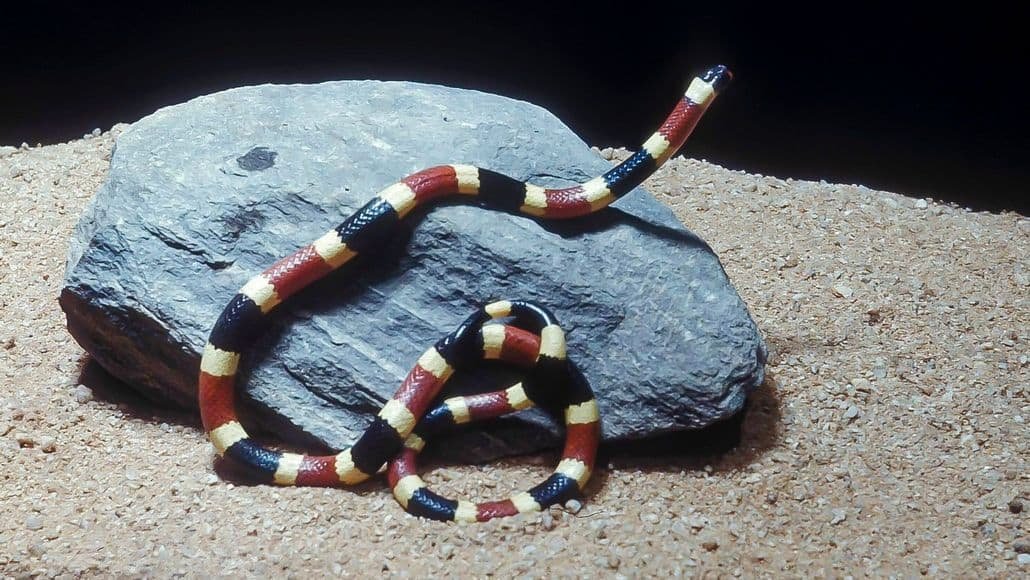
Next, we will answer some common questions related to snakes that strongly resemble the coral snake. If you have any additional questions, please feel free to ask them below.
What Looks Like A Coral Snake But Is Not Poisonous?
Milk snakes, scarlet snakes, scarlet king snakes, and Sonoran shovel-nosed snakes are mimics or look-alikes of coral snakes, but are not poisonous. If you have ever wondered “How do snakes protect themselves?”, this mimicry is one of the ways some species do so.
What Florida Snakes Look Like Coral Snakes?
The Florida scarlet snake looks like a coral snake, but without venom.
What Is The Difference Between A Coral Snake And A False Coral Snake?
The main difference between a coral snake and a false coral snake is that the latter is non-venomous. The red, orange, and pink bands on the false coral snake also have black outlines, which give them a speckled appearance.
Coral Snake Look-Alikes: Final Thoughts
There are a number of non-venomous snakes that mimic the venomous coral snake. This has the advantage that predators are scared to mess with them.
Of course, it also has the disadvantage that humans are more likely to kill them, thinking they are a dangerous, and potentially deadly, coral snake.
It should go without saying that you should not kill any snakes, even if they are venomous. Snakes perform a vital function in nature.
If you stumble upon a snake that looks like a coral snake, but you are not sure if it actually is one or not, just err on the side of caution. Keep your distance.
Leave a Reply